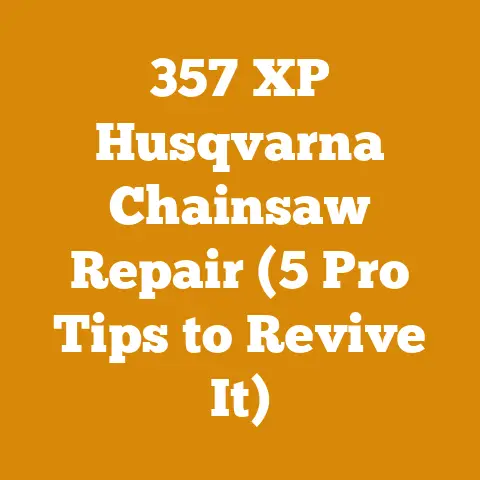Lopper vs Shear: Best Pruning Tools (5 Expert Tips)
Let’s talk about pruning.
I’ve always been fascinated by the art of layering in gardening and landscaping.
It’s like creating different levels of beauty and functionality, each contributing to the overall harmony of the space.
Whether it’s the towering trees providing shade, the mid-level shrubs offering structure, or the ground cover adding texture, every layer plays a crucial role.
And to maintain this balance, pruning is essential.
But what happens when you need to reach for more specialized tools than your trusty hand pruners?
That’s where loppers and shears come into the picture.
I’ve spent countless hours tending my own small orchard and helping friends manage their properties.
Through trial and error, I’ve learned firsthand the importance of choosing the right tool for the job.
It’s not just about cutting branches; it’s about promoting healthy growth, preventing disease, and shaping the landscape to its full potential.
So, in this guide, I’m going to share my experiences and expertise to help you understand the differences between loppers and shears, and how to choose the best pruning tool for your needs.
I will be covering expert tips, technical specifications, and practical advice to ensure you get the most out of your pruning efforts.
Let’s dive in!
Lopper vs. Loppers and shears are two essential instruments in any gardener’s or landscaper’s arsenal, each designed for specific tasks. Understanding their differences and knowing when to use each one can significantly improve your pruning efficiency and the health of your plants. What are Loppers?
Loppers are essentially long-handled pruning shears, designed for cutting thicker branches that are beyond the capability of hand pruners.
Their long handles provide leverage, allowing you to cut through branches with greater force and less effort.
Types of Loppers
- Bypass Loppers: These have two blades that pass each other like scissors.
They are ideal for making clean cuts on living branches, minimizing damage to the plant. - Anvil Loppers: These have one sharp blade that cuts against a flat, broad surface (the anvil).
They are better for cutting dead or dry wood, as they can crush living tissue. - Ratchet Loppers: These use a ratcheting mechanism to make cutting easier.
Each squeeze of the handles advances the blade further, making them suitable for thicker branches that require more force. - Compound Action Loppers: These use a system of levers to multiply the force applied to the blades.
Great for cutting through very thick branches with minimal effort.
Technical Specifications of Loppers
- Handle Length: Typically ranges from 16 to 36 inches.
Longer handles provide more leverage but can be cumbersome in tight spaces. - Cutting Capacity: Usually between 1 to 2 inches in diameter for most models.
Heavy-duty loppers can handle up to 3 inches. - Blade Material: High-carbon steel blades are common due to their durability and ability to hold an edge.
Some blades are coated with Teflon or other materials to reduce friction and prevent rust. - Weight: Varies depending on the model and materials used.
Lighter loppers (around 2-3 pounds) are easier to handle for extended periods. - Handle Material: Options include wood, fiberglass, and steel with rubber grips.
Fiberglass and steel handles are more durable, while wooden handles offer a classic feel.
When to Use Loppers
- Cutting Branches: Loppers are perfect for cutting branches that are too thick for hand pruners but not large enough to require a saw.
- Reaching High Branches: The long handles allow you to reach higher branches without needing a ladder, enhancing safety.
- Pruning Shrubs and Small Trees: Ideal for shaping shrubs and small trees, removing dead or diseased wood, and maintaining their overall structure.
What are Shears?
Shears, on the other hand, are designed for trimming and shaping hedges, shrubs, and other foliage.
They have long blades and two handles, similar to scissors, allowing you to make uniform cuts across a wide area.
Types of Shears
- Hedge Shears: These have long, straight blades and are used for shaping hedges and shrubs.
They can be either manual or powered. - Grass Shears: Designed for trimming grass along edges and in hard-to-reach areas.
They often have a rotating blade for versatile use. - Topiary Shears: These have shorter blades and are used for detailed shaping and sculpting of plants.
Technical Specifications of Shears
- Blade Length: Typically ranges from 6 to 10 inches for hedge shears.
Shorter for topiary shears and grass shears. - Blade Material: Similar to loppers, high-carbon steel is a common choice for its durability.
- Handle Length: Varies depending on the type of shears.
Hedge shears usually have longer handles for better reach and leverage. - Weight: Lighter than loppers, usually around 1-2 pounds, to reduce fatigue during extended use.
- Power Source: Hedge shears can be manual, electric, or gas-powered.
Electric and gas-powered shears are faster and more efficient for large hedges.
When to Use Shears
- Shaping Hedges: Shears are perfect for creating clean, uniform lines on hedges, giving them a neat and tidy appearance.
- Trimming Shrubs: Ideal for maintaining the shape and size of shrubs, removing overgrown foliage, and promoting healthy growth.
- Edging Lawns: Grass shears are designed for trimming grass along edges, around flower beds, and in other tight spaces.
- Topiary: Topiary shears allow for precise shaping and detailing, making them essential for creating intricate designs.
Expert Tip #1: Understanding Blade Types and Their Applications
The type of blade on your lopper or shear significantly impacts its performance and suitability for different pruning tasks.
Here’s a deeper dive into blade types and their applications:
Bypass Blades vs. Anvil Blades: A Detailed Comparison
Bypass Blades:
- Mechanism: These blades work like scissors, with two curved blades that pass closely by each other to make a clean cut.
- Best For: Live, green wood.
The clean cut minimizes damage to the plant, allowing it to heal quickly and reducing the risk of disease. - Cutting Action: The slicing action is gentle on the plant’s tissues, preventing crushing and tearing.
- Maintenance: Requires regular sharpening to maintain the clean, scissor-like action.
- Example: I once used bypass loppers to prune a young apple tree.
The clean cuts I made helped the tree heal quickly, and it produced a bountiful harvest the following year. - Technical Note: The bypass blades should be aligned precisely to avoid any gap that could cause tearing.
A slight misalignment can significantly reduce the efficiency and quality of the cut.
Anvil Blades:
- Mechanism: These blades have a single, sharp blade that closes against a flat, broad surface (the anvil).
- Best For: Dead, dry wood.
The crushing action is less critical on dead wood, and the anvil design provides more power for cutting through tough, brittle branches. - Cutting Action: The crushing action can damage live tissue, making it less suitable for green wood.
- Maintenance: Requires less frequent sharpening than bypass blades, as the cutting action is less dependent on a razor-sharp edge.
- Example: I used anvil loppers to clear out dead branches from an old oak tree.
The anvil design allowed me to cut through the dry, hard wood with ease. - Technical Note: The anvil should be made of a durable material, such as hardened steel or high-quality plastic, to withstand the force of the blade.
The blade should be sharp enough to make a clean initial cut before the crushing action takes over.
Blade Material: High-Carbon Steel vs. Stainless Steel
High-Carbon Steel Blades:
- Pros:
- Sharpness: Holds an edge very well, allowing for clean, precise cuts.
- Durability: Can withstand heavy use and maintain its shape.
- Ease of Sharpening: Relatively easy to sharpen with the right tools and techniques.
- Cons:
- Rust: Prone to rust if not properly cleaned and oiled.
- Maintenance: Requires regular maintenance to prevent rust and maintain sharpness.
- Technical Data: High-carbon steel typically contains 0.6% to 1.25% carbon.
The higher carbon content increases the hardness and strength of the steel. - Care Tip: I always clean my high-carbon steel blades after each use and apply a light coat of oil to prevent rust.
This simple step can significantly extend the life of your tools.
Stainless Steel Blades:
- Pros:
- Rust Resistance: Highly resistant to rust and corrosion.
- Low Maintenance: Requires less maintenance than high-carbon steel.
- Cons:
- Sharpness: Does not hold an edge as well as high-carbon steel.
- Durability: Can be more brittle than high-carbon steel and prone to chipping.
- Sharpening: More difficult to sharpen due to its hardness.
- Technical Data: Stainless steel contains at least 10.5% chromium, which forms a passive layer of chromium oxide on the surface, preventing rust.
- Personal Experience: While stainless steel blades are convenient due to their rust resistance, I prefer high-carbon steel for its superior sharpness and durability.
The extra maintenance is worth it for the cleaner, more precise cuts.
Blade Coatings: Teflon vs. Non-Stick
Teflon-Coated Blades:
- Pros:
- Reduced Friction: The Teflon coating reduces friction, making it easier to cut through branches.
- Rust Resistance: Provides some protection against rust and corrosion.
- Easy Cleaning: Sap and debris are less likely to stick to the blade, making it easier to clean.
- Cons:
- Durability: The Teflon coating can wear off over time, reducing its effectiveness.
- Technical Note: Teflon (Polytetrafluoroethylene or PTFE) has a very low coefficient of friction (typically around 0.04), making it ideal for reducing friction on cutting blades.
- Practical Tip: I’ve found that Teflon-coated blades are particularly useful when pruning resinous trees like pines and firs.
The coating prevents the sticky resin from gumming up the blades.
Non-Stick Coated Blades:
- Pros:
- Reduced Friction: Similar to Teflon, non-stick coatings reduce friction and make cutting easier.
- Easy Cleaning: Sap and debris are less likely to stick to the blade.
- Cons:
- Durability: The coating can wear off over time.
- Effectiveness: May not be as effective as Teflon in reducing friction.
- Technical Note: Non-stick coatings are typically made from a blend of polymers and other materials.
While they are effective at reducing friction, they may not be as durable as Teflon. - Insight: I’ve used both Teflon-coated and non-stick coated blades, and I’ve found that Teflon generally performs better in terms of durability and friction reduction.
However, non-stick coatings can be a good option for lighter pruning tasks.
Expert Tip #2: Mastering Cutting Techniques for Optimal Plant Health
Pruning is not just about cutting branches; it’s about understanding how plants respond to pruning and using the right techniques to promote healthy growth.
Making Clean Cuts: The 45-Degree Rule
- Why It Matters: Making clean cuts is crucial for preventing disease and promoting rapid healing.
A jagged or torn cut can create an entry point for pathogens and slow down the healing process. - The 45-Degree Rule: When pruning a branch, make the cut at a 45-degree angle, just above a bud or another branch.
This angle allows water to run off the cut surface, reducing the risk of rot and infection. - Technical Explanation: The 45-degree angle maximizes the surface area for callus formation, which is the protective tissue that seals the wound.
It also minimizes the amount of exposed wood, reducing the risk of desiccation and cracking. - Personal Experience: I once neglected to follow the 45-degree rule when pruning a rose bush.
The resulting jagged cuts became infected, and the bush suffered for months.
Since then, I’ve always paid close attention to making clean, angled cuts. - Step-by-Step Guide:
- Identify the bud or branch you want to prune above.
- Position your lopper or shear at a 45-degree angle to the branch.
- Make a clean, swift cut, avoiding any twisting or tearing.
- Inspect the cut to ensure it is smooth and angled correctly.
Pruning for Airflow and Sunlight: Removing Crowded Branches
- Why It Matters: Crowded branches can restrict airflow and sunlight penetration, creating a humid environment that is conducive to fungal diseases.
Removing crowded branches improves air circulation and allows sunlight to reach all parts of the plant, promoting healthy growth. - Identifying Crowded Branches: Look for branches that are crossing, rubbing, or growing inward towards the center of the plant.
These branches are likely to be competing for resources and blocking airflow and sunlight. - Technical Insight: Proper airflow reduces the humidity around the plant, making it less susceptible to fungal diseases like powdery mildew and black spot.
Sunlight is essential for photosynthesis, which provides the energy plants need to grow and thrive. - Case Study: I helped a friend prune an overgrown lilac bush that was suffering from powdery mildew.
By removing crowded branches and opening up the canopy, we significantly improved airflow and sunlight penetration.
The following year, the bush was much healthier and produced more flowers. - Pruning Techniques:
- Start by removing any dead, diseased, or damaged branches.
- Identify crowded branches that are crossing, rubbing, or growing inward.
- Use loppers or shears to remove these branches, making clean cuts at the branch collar.
- Step back and assess the overall shape and structure of the plant.
- Make any additional cuts as needed to create an open, airy canopy.
Pruning at the Right Time of Year: Understanding Dormancy
- Why It Matters: Pruning at the wrong time of year can stress plants and make them more susceptible to disease.
Understanding the dormancy cycle of plants is essential for timing your pruning correctly. - Dormancy: Dormancy is a period of inactivity that plants undergo during the winter months.
During this time, plants conserve energy and are less susceptible to damage from pruning. - Technical Explanation: Pruning during dormancy minimizes the loss of sap and energy, allowing the plant to focus on healing and growth in the spring.
It also reduces the risk of attracting pests and diseases, which are less active during the winter. - General Rule: Most deciduous trees and shrubs should be pruned during late winter or early spring, before new growth begins.
Evergreen trees and shrubs can be pruned in late winter or early summer, after the new growth has hardened off. - Exceptions: There are some exceptions to this rule.
For example, spring-flowering shrubs like lilacs and forsythias should be pruned immediately after they finish blooming, to avoid removing the flower buds for the following year. - Practical Tip: I keep a pruning calendar to remind myself when to prune different types of plants in my garden.
This helps me stay organized and avoid making mistakes.
Preventing Disease Spread: Disinfecting Your Tools
- Why It Matters: Pruning tools can spread diseases from one plant to another.
Disinfecting your tools after each use is essential for preventing the spread of pathogens. - Disinfecting Solutions:
- Isopropyl Alcohol: A 70% solution of isopropyl alcohol is effective at killing most plant pathogens.
- Bleach: A 10% bleach solution (1 part bleach to 9 parts water) is also effective, but it can be corrosive to metal tools.
- Commercial Disinfectants: There are many commercial disinfectants available specifically for pruning tools.
- Technical Note: Some pathogens, like viruses, can be very persistent and difficult to eradicate.
It’s important to use a strong disinfectant and follow the manufacturer’s instructions carefully. - Step-by-Step Guide:
- Clean your pruning tools with soap and water to remove any dirt or debris.
- Soak the blades in the disinfecting solution for at least 30 seconds.
- Rinse the tools with clean water.
- Dry the tools thoroughly before storing them.
- Personal Story: I once unknowingly spread fire blight from an infected pear tree to a healthy apple tree.
Since then, I’ve always been diligent about disinfecting my pruning tools.
Expert Tip #3: Choosing the Right Tool Size and Weight
Selecting the appropriate size and weight of your loppers and shears is crucial for comfort, efficiency, and safety.
A tool that is too heavy or too long can lead to fatigue and increase the risk of injury.
Handle Length: Reach vs. Control
- Loppers:
- Shorter Handles (16-24 inches): Ideal for smaller individuals or those working in tight spaces.
They offer greater control and maneuverability. - Longer Handles (24-36 inches): Provide more leverage and reach, making them suitable for cutting thicker branches and reaching higher into trees and shrubs.
- Shorter Handles (16-24 inches): Ideal for smaller individuals or those working in tight spaces.
- Shears:
- Shorter Handles (6-12 inches): Best for detailed work and shaping smaller plants.
They offer precise control. - Longer Handles (12-24 inches): Provide greater reach and leverage for shaping larger hedges and shrubs.
- Shorter Handles (6-12 inches): Best for detailed work and shaping smaller plants.
- Technical Consideration: The handle length affects the mechanical advantage of the tool.
Longer handles increase leverage, reducing the amount of force required to make a cut.
However, they also reduce control and maneuverability. - Personal Experience: I have both short-handled and long-handled loppers.
I use the short-handled loppers for pruning in my small vegetable garden, where space is limited.
I use the long-handled loppers for pruning trees and shrubs in my yard, where I need the extra reach and leverage. - Recommendation: Choose a handle length that is appropriate for your height, strength, and the type of pruning you will be doing.
If you are unsure, it’s better to err on the side of shorter handles, as they offer more control.
Weight: Balancing Power and Endurance
- Loppers:
- Lightweight (2-3 pounds): Easier to handle for extended periods, reducing fatigue.
Suitable for smaller branches and lighter pruning tasks. - Heavyweight (3-5 pounds): Provide more power for cutting thicker branches.
Better suited for heavy-duty pruning tasks.
- Lightweight (2-3 pounds): Easier to handle for extended periods, reducing fatigue.
- Shears:
- Lightweight (1-2 pounds): Essential for reducing fatigue during long shaping and trimming sessions.
- Heavyweight (2-3 pounds): Offer more power for cutting thicker hedges and shrubs.
- Technical Data: The weight of the tool affects the amount of force required to use it.
Heavier tools require more effort to lift and maneuver, which can lead to fatigue and increase the risk of injury. - Case Study: A friend of mine, who is a professional landscaper, developed carpal tunnel syndrome from using heavy pruning tools for extended periods.
Since then, he has switched to lighter tools and uses ergonomic techniques to reduce strain on his wrists and hands. - Ergonomic Considerations:
- Choose tools with padded grips to reduce pressure on your hands.
- Use a comfortable stance and avoid overreaching.
- Take frequent breaks to rest your hands and arms.
- Consider using a tool belt to distribute the weight of your tools.
Handle Material: Wood vs. Fiberglass vs. Steel
- Wood Handles:
- Pros:
- Comfortable to grip.
- Absorbs vibration.
- Traditional feel.
- Cons:
- Less durable than fiberglass or steel.
- Can be affected by moisture.
- May require more maintenance.
- Pros:
- Fiberglass Handles:
- Pros:
- Durable and weather-resistant.
- Lightweight.
- Strong and flexible.
- Cons:
- Can be slippery when wet.
- May not absorb vibration as well as wood.
- Pros:
- Steel Handles:
- Pros:
- Extremely durable.
- Strong and rigid.
- Cons:
- Heavy.
- Can transmit vibration.
- May be uncomfortable to grip.
- Pros:
- Material Science: Wood handles are typically made from hardwoods like ash or hickory, which are strong and durable.
Fiberglass handles are made from a composite material that is lightweight and weather-resistant.
Steel handles are made from high-carbon steel, which is extremely strong and durable. - Personal Preference: I prefer fiberglass handles for their durability and weather resistance.
They are also lightweight and comfortable to grip, even when wet.
Expert Tip #4: Maintaining Your Pruning Tools for Longevity
Proper maintenance is essential for keeping your loppers and shears in top condition and extending their lifespan.
Regular cleaning, sharpening, and lubrication will ensure that your tools perform optimally and prevent rust and corrosion.
Cleaning: Removing Sap and Debris
- Why It Matters: Sap and debris can accumulate on the blades of your pruning tools, making them sticky and difficult to use.
They can also promote rust and corrosion. - Cleaning Solutions:
- Soap and Water: A mild solution of soap and water is effective for removing most sap and debris.
- Mineral Spirits: Mineral spirits can be used to remove stubborn sap and resin.
- Commercial Cleaners: There are many commercial cleaners available specifically for pruning tools.
- Step-by-Step Guide:
- Wipe the blades with a damp cloth to remove loose dirt and debris.
- Soak the blades in a solution of soap and water for a few minutes.
- Scrub the blades with a stiff brush to remove any remaining sap and debris.
- Rinse the blades with clean water.
- Dry the blades thoroughly with a clean cloth.
- Technical Note: Sap contains sugars and other organic compounds that can attract pests and promote the growth of mold and mildew.
Removing sap and debris not only improves the performance of your tools but also helps to prevent the spread of disease. - Personal Experience: I once neglected to clean my loppers after pruning a pine tree.
The sticky resin hardened on the blades, making them difficult to use.
It took me hours to clean them properly.
Sharpening: Keeping Blades Sharp
- Why It Matters: Sharp blades are essential for making clean, precise cuts.
Dull blades can tear and crush plant tissue, increasing the risk of disease and slowing down the healing process. - Sharpening Tools:
- File: A flat file or a mill file is suitable for sharpening most pruning tools.
- Sharpening Stone: A sharpening stone can be used to hone the blades to a razor-sharp edge.
- Diamond Sharpener: A diamond sharpener is a quick and easy way to sharpen pruning tools.
- Sharpening Techniques:
- Bypass Blades: Follow the original bevel of the blade, using smooth, even strokes.
- Anvil Blades: Sharpen the beveled edge of the blade, maintaining the original angle.
- Step-by-Step Guide:
- Secure the blade in a vise or clamp.
- Hold the sharpening tool at the correct angle.
- Use smooth, even strokes to sharpen the blade, working from the base to the tip.
- Repeat the process until the blade is sharp.
- Test the sharpness of the blade by cutting a piece of paper or cardboard.
- Technical Insight: The angle of the blade bevel is critical for maintaining its sharpness.
A steeper angle will create a sharper edge, but it will also be more prone to chipping.
A shallower angle will be more durable but less sharp. - Practical Tip: I sharpen my pruning tools every few weeks, or whenever I notice that they are becoming dull.
This helps to ensure that they are always ready to use.
Lubrication: Preventing Rust and Corrosion
- Why It Matters: Lubrication prevents rust and corrosion, keeping your pruning tools in good working condition.
It also reduces friction, making them easier to use. - Lubricants:
- Machine Oil: A light machine oil, such as 3-in-1 oil, is suitable for lubricating most pruning tools.
- Penetrating Oil: A penetrating oil, such as WD-40, can be used to loosen rusted or stuck parts.
- Grease: A heavy grease can be used to lubricate moving parts, such as hinges and pivots.
- Step-by-Step Guide:
- Clean the blades and moving parts of your pruning tools.
- Apply a thin coat of lubricant to the blades and moving parts.
- Wipe off any excess lubricant.
- Technical Data: Lubricants work by creating a thin film between moving parts, reducing friction and wear.
They also protect metal surfaces from moisture and oxygen, preventing rust and corrosion. - Personal Story: I once left my loppers outside in the rain.
The blades rusted, and the tool became difficult to use.
Since then, I’ve always made sure to lubricate my pruning tools after each use.
Storage: Protecting Your Tools
- Why It Matters: Proper storage protects your pruning tools from damage and prolongs their lifespan.
- Storage Tips:
- Store your pruning tools in a dry, protected location, such as a shed or garage.
- Hang your pruning tools on a wall or in a tool rack to prevent them from getting damaged.
- Cover the blades of your pruning tools with a protective sheath or wrap them in a cloth to prevent them from getting dull.
- Store your pruning tools away from children and pets.
- Technical Note: Extreme temperatures and humidity can damage pruning tools.
Storing them in a climate-controlled environment will help to prevent rust, corrosion, and other types of damage. - Insight: I have a dedicated tool rack in my garage where I store all of my pruning tools.
This keeps them organized and protected.
Expert Tip #5: Prioritizing Safety When Pruning
Pruning can be a rewarding task, but it’s essential to prioritize safety to prevent accidents and injuries.
Wearing the right protective gear, using proper techniques, and being aware of your surroundings can help you stay safe while pruning.
Essential Safety Gear: Protecting Yourself
- Gloves:
- Why They’re Important: Gloves protect your hands from cuts, scratches, and thorns.
- Types of Gloves: Choose gloves that are durable and provide a good grip.
Leather gloves are a good option for heavy-duty pruning tasks. - Technical Specification: Look for gloves that are made from puncture-resistant materials, such as leather or synthetic fabrics.
- Eye Protection:
- Why It’s Important: Eye protection prevents debris, sap, and branches from getting into your eyes.
- Types of Eye Protection: Wear safety glasses or goggles that provide full coverage.
- Safety Standard: Ensure your eye protection meets ANSI Z87.1 standards for impact resistance.
- Hearing Protection:
- Why It’s Important: Hearing protection is essential when using power tools, such as electric or gas-powered shears.
- Types of Hearing Protection: Wear earplugs or earmuffs that provide adequate noise reduction.
- Noise Reduction Rating (NRR): Choose hearing protection with an NRR of at least 20 decibels.
- Long Sleeves and Pants:
- Why They’re Important: Long sleeves and pants protect your skin from scratches, insect bites, and exposure to the sun.
- Material: Choose clothing that is durable and comfortable to wear.
- Sturdy Footwear:
- Why It’s Important: Sturdy footwear provides support and traction, preventing slips and falls.
- Types of Footwear: Wear work boots or hiking boots with non-slip soles.
- Safety Feature: Look for footwear with steel toes for added protection.
- Hard Hat:
- Why It’s Important: A hard hat protects your head from falling branches and other debris.
- When to Wear: Wear a hard hat when pruning trees or working in areas where there is a risk of falling objects.
- Safety Standard: Ensure your hard hat meets ANSI Z89.1 standards for impact resistance.
Ladder Safety: Working at Heights
- Choosing the Right Ladder:
- Type: Use a ladder that is appropriate for the height and type of pruning you will be doing.
- Material: Choose a ladder that is made from a durable material, such as aluminum or fiberglass.
- Weight Capacity: Ensure the ladder has a weight capacity that is sufficient for your weight and the weight of your tools.
- Technical Specification: Look for ladders that meet ANSI A14.2 standards for safety.
- Setting Up the Ladder:
- Stable Ground: Place the ladder on a firm, level surface.
- Angle: Set the ladder at a 75-degree angle to the wall or tree.
- Extension: Extend the ladder at least 3 feet above the branch you will be pruning.
- Locking Mechanisms: Ensure all locking mechanisms are engaged before climbing the ladder.
- Climbing the Ladder:
- Three Points of Contact: Maintain three points of contact with the ladder at all times.
- Center of Gravity: Keep your center of gravity within the rails of the ladder.
- Overreaching: Avoid overreaching or leaning too far to one side.
- Tools: Use a tool belt to keep your hands free.
- Safety Tip: I always have someone spot me when I’m working on a ladder.
This provides an extra layer of safety and can help prevent accidents.
Electrical Safety: Avoiding Power Lines
- Identifying Power Lines:
- Overhead Power Lines: Be aware of the location of overhead power lines before you start pruning.
- Underground Power Lines: Call your local utility company to locate underground power lines before digging or pruning near them.
- Maintaining a Safe Distance:
- Minimum Distance: Maintain a minimum distance of 10 feet from overhead power lines.
- Professional Help: If you need to prune trees near power lines, hire a qualified arborist who is trained in electrical safety.
- Using Insulated Tools:
- Insulated Handles: Use pruning tools with insulated handles to protect yourself from electric shock.
- Insulation Rating: Ensure the tools are rated for the voltage of the power lines in your area.
- Emergency Procedures:
- Contact: If you accidentally contact a power line, do not touch the tree or the ground.
- Call for Help: Call 911 or your local emergency number immediately.
- Safety Regulation: OSHA regulations require employers to provide training and equipment to protect workers from electrical hazards.
First Aid: Being Prepared
- First Aid Kit:
- Contents: Keep a well-stocked first aid kit on hand, including bandages, antiseptic wipes, pain relievers, and other essential supplies.
- Location: Store the first aid kit in a convenient and accessible location.
- Basic First Aid Skills:
- CPR: Learn CPR and basic first aid skills.
- Wound Care: Know how to clean and dress wounds.
- Emergency Procedures: Be familiar with emergency procedures, such as calling for help and providing basic medical assistance.
- Medical Information:
- Allergies: Be aware of any allergies you or your coworkers may have.
- Medical Conditions: Know about any medical conditions that could affect your ability to work safely.
- Safety Checklist:
- Inspect Tools: Before starting work, inspect your pruning tools for damage and ensure they are in good working condition.
- Protective Gear: Wear all necessary protective gear, including gloves, eye protection, and hearing protection.
- Ladder Safety: Set up the ladder safely and maintain three points of contact at all times.
- Electrical Safety: Be aware of the location of power lines and maintain a safe distance.
- Weather Conditions: Check the weather forecast and avoid pruning in hazardous conditions, such as high winds or thunderstorms.
By following these safety tips, you can minimize the risk of accidents and injuries and enjoy a safe and productive pruning experience.
Conclusion: The Art and Science of Pruning
Choosing between loppers and shears isn’t just about picking a tool; it’s about understanding the specific needs of your plants and the environment in which they grow.
I’ve always believed that pruning is both an art and a science.
The art lies in shaping the plant to enhance its natural beauty and promote its overall health.
The science involves understanding the plant’s growth habits, its response to pruning, and the best techniques for achieving your desired results.
From selecting the right blade type to mastering cutting techniques and prioritizing safety, each aspect plays a crucial role in successful pruning.
Remember to consider the size and weight of the tools, maintain them regularly, and always wear appropriate safety gear.






